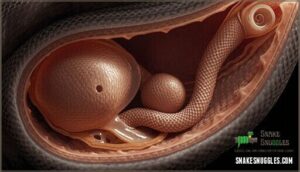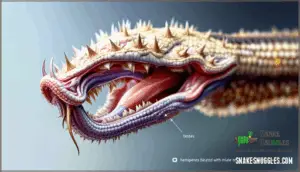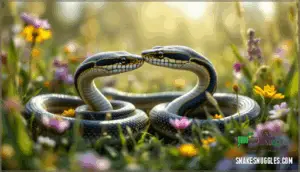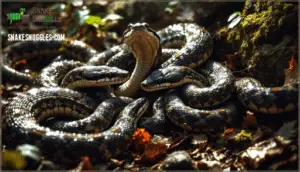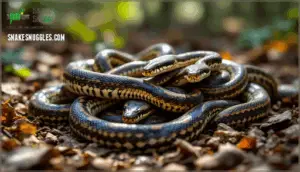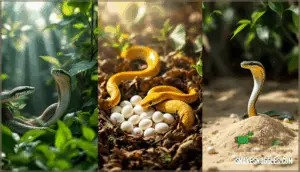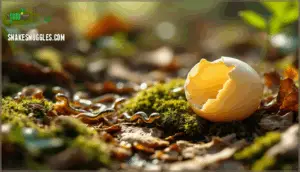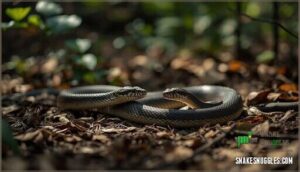This site is supported by our readers. We may earn a commission, at no cost to you, if you purchase through links.
 If you’ve ever watched a cluster of snakes writhing together in early spring, you’ve witnessed one of nature’s more enigmatic courtship rituals. The way snakes mate isn’t just a matter of chance encounters—there’s a complex choreography unfolding beneath those scales.
If you’ve ever watched a cluster of snakes writhing together in early spring, you’ve witnessed one of nature’s more enigmatic courtship rituals. The way snakes mate isn’t just a matter of chance encounters—there’s a complex choreography unfolding beneath those scales.
Males track pheromone trails with astonishing precision, vying for the attention of females who make their own quiet choices amid the chaos. From the peculiar structure of the hemipenis to the subtle dance of cloacal alignment, the mechanics of snake reproduction reveal a world where anatomy, timing, and competition collide.
Understanding how snakes mate uncovers a story of adaptation and survival hidden in plain sight.
Table Of Contents
Key Takeaways
- Male snakes track receptive females using pheromone trails, then engage in species-specific courtship rituals—from gentle stroking in boids to aggressive chasing in colubrids—before copulation occurs through cloacal alignment and hemipenis insertion, which can last anywhere from minutes to hours depending on environmental conditions and anatomical features like anchoring spikes.
- Snake reproduction involves diverse strategies shaped by climate and habitat, including egg-laying (oviparity) in most species, live birth (viviparity) in cold climates where external eggs wouldn’t survive, and intermediate methods like ovoviviparity, with some species even capable of rare asexual reproduction through parthenogenesis when males aren’t available.
- Mating balls form when multiple males compete for a single female, creating intense physical competition where the strongest, most persistent males win reproductive access—but females ultimately control fertilization through specialized sperm storage tubules that can retain viable sperm for months or years, allowing cryptic mate selection long after mating ends.
- Post-mating behavior varies dramatically by species, with most snakes immediately separating and females often becoming territorial or hostile, while parental investment ranges from pythons coiling protectively around eggs for weeks to most species abandoning their clutches entirely and leaving hatchling survival to environmental chance.
How Do Snakes Mate?
If you’ve ever wondered how snakes manage to mate without limbs, prepare to discover a process that’s equal parts elegant biology and intense competition. Male snakes track down receptive females by following pheromone trails, chemical signals that announce a female’s readiness.
Once they meet, snake courtship rituals unfold—males stroke, vibrate, or even chase females to initiate mating. The actual process involves cloacal alignment, where the male wraps his tail around the female’s and everts one hemipenis into her cloaca. Hemipenis anchoring, achieved through spikes or hooks, guarantees successful sperm transfer. Mating duration varies widely, from minutes to hours.
Females then store sperm in specialized tubules for months or even years, controlling when fertilization occurs. These mating behaviors in snakes reveal striking adaptations shaped by millions of years of evolution.
Female snakes store sperm for months or years in specialized tubules, controlling fertilization timing through adaptations shaped by millions of years of evolution
Snake Reproductive Organs
Understanding snake reproduction starts with their unique anatomy. Male and female snakes have specialized organs that differ greatly from mammals, each adapted for their specific reproductive roles.
Let’s look at how these structures work in both sexes.
Female: Vagina, Oviducts, Ovaries, Clitoris
Female snakes pack some surprisingly complex reproductive hardware beneath those scales—think of it as nature’s version of a multipurpose toolkit designed for long-term success. The cloaca acts as the central opening where reproductive organs connect to the outside world. Inside, paired ovaries produce eggs during seasonal cycles, with ovary size fluctuating based on breeding readiness. The oviducts serve as highways where fertilization occurs and eggs develop protective shells.
Here’s where female anatomy gets really interesting:
- Sperm storage tubules in the oviduct function can keep sperm viable for months or even years after mating
- Cryptic choice allows females to selectively use stored sperm from different males
- Clitoris homology exists in snakes, though its exact role in female reproduction remains under study
- Specialized oviduct regions take care of everything from fertilization to egg coating
This intricate setup gives female snakes considerable control over their reproductive timing and offspring genetics.
Male: Hemipenis, Testes, Sperm Duct
Male snakes carry their reproductive equipment in a setup that’s just as specialized as the females’—only theirs comes with a built-in backup system. Tucked inside the cloaca, paired hemipenes wait until mating time to make their appearance. Hemipenis morphology varies wildly depending on species—some feature spikes, hooks, or ridges that anchor them during copulation, kind of like nature’s version of Velcro. Only one hemipenis gets deployed at a time, but having two means males can alternate sides or compensate if one gets damaged during male competition.
Behind this hardware, the testes oversee sperm production year-round or seasonally, depending on climate. Sperm travels through the sperm duct to the cloaca, where it’s transferred during mating. Some species even deposit mating plugs afterward—a waxy barrier that blocks rival males from fertilizing the same female. It’s reproductive strategy meets male anatomy in action.
Snake Mating Season
Snake mating season isn’t a one-size-fits-all situation—it depends heavily on where a species lives and what environmental cues it reacts to. Most snakes time their breeding to give their offspring the best shot at survival, which means temperature, rainfall, and food availability all play a role.
Here’s how different climates and conditions shape when snakes decide to reproduce.
Springtime After Hibernation (temperate Climates)
In temperate climates, the first warm days after winter hibernation trigger one of nature’s most predictable reproductive rushes—snakes emerge from their communal dens hungry, alert, and ready to mate before they even think about food. This mating urgency is driven by temperature cues that signal the end of brumation, when snakes synchronize their emergence timing with warming conditions. Their energy reserves, built up before hibernation, fuel courtship rather than hunting.
Here’s what drives this spring mating rush:
- Males track female pheromones immediately upon emergence
- Thermoregulation needs are met by basking near den sites
- Predation risks are minimized through synchronized mass emergence
This strategic timing guarantees offspring develop during peak summer warmth.
Multiple Mating Seasons in Tropical Climates
Unlike their temperate cousins who sync their sex lives to the spring thaw, tropical snakes don’t wait for any particular season—they’re equipped to breed whenever conditions align with food availability and rainfall patterns. Year-round breeding is possible thanks to stable temperatures, though many species time copulation with environmental factors. Continuous copulation activity occurs when resources are plentiful, while follicle enlargement peaks during the dry season in many tropical species. Female snakes may mate during the rainy season when prey abundance sustains gestation.
| Climate Pattern | Breeding Season Activity | Key Reproductive Event |
|---|---|---|
| Dry Season | Peak follicle enlargement | Mating preparation begins |
| Early Rainy Season | Increased copulation | Sperm transfer occurs |
| Mid Rainy Season | Continued mating | Secondary follicle growth |
| Late Rainy Season | Gestation progresses | Offspring development |
| Year-round | Flexible reproduction | Multiple mating opportunities |
This flexibility means snake mating season variations in the tropics reflect resource pulses rather than temperature swings.
Dependent on Climate and Ecosystem
Snake reproduction syncs tightly with climate patterns and ecosystem rhythms, guaranteeing offspring arrive when conditions favor survival. Temperature shifts, rainfall cycles, and food availability all shape when you’ll see snakes ready to breed. Species adaptation means temperate snakes respond to spring warming after hibernation, while tropical populations show breeding plasticity—adjusting reproductive timing based on resource pulses rather than rigid seasonal calendars.
Climate synchronization guarantees that environmental conditions match the energy demands of courtship, gestation, and offspring care. Range shifts caused by changing temperatures have forced some populations to alter their mating windows entirely, demonstrating how ecosystem impact directly influences reproductive success. Long-term studies reveal climate change impacts on survival rates, especially in thermophilic species.
- Temperature swings trigger hormonal changes that initiate breeding
- Rainfall patterns affect prey abundance and habitat suitability
- Food availability determines whether females have enough reserves to reproduce
- Seasonal stability allows tropical species greater reproductive flexibility throughout the year
Delay in Reproduction if Risky Behavior is Required
When survival hangs in the balance, reproduction takes a backseat to staying alive. Snakes assess their environment constantly, weighing the risk-reward balance before committing energy to mating. If predator avoidance becomes essential or habitat quality deteriorates, they’ll postpone reproduction entirely.
This energy conservation strategy reflects intricate species adaptation—females especially can’t afford to breed when environmental conditions threaten their survival or that of their offspring. Food scarcity, extreme temperatures, or dangerous territorial conflicts all trigger delayed maturity in younger individuals.
Environmental factors affecting reproduction work like a biological checkpoint system, preventing wasteful breeding attempts when success rates plummet. By reading these environmental signals, snakes demonstrate considerable flexibility in their mating actions, guaranteeing they only reproduce when conditions genuinely support the future generation’s survival chances.
Selection of Most Suitable Period for Birthing
Female snakes orchestrate their reproductive calendar with striking precision, aligning birth timing to when their young have the highest chance of thriving. This seasonal breeding strategy responds directly to environmental factors affecting reproduction—temperature, moisture, and prey abundance all influence when females complete their gestation length. Evolutionary pressures have fine-tuned this snake reproductive cycle over millennia, making certain offspring survival rates peak when climate influence and resource availability align favorably during breeding season.
Strategic timing considerations include:
- Temperature optimization: Warm conditions accelerate hatchling metabolism and hunting success
- Prey synchronization: Birthing coincides with seasonal abundance of appropriately sized food items
- Shelter availability: Adequate cover protects vulnerable newborns from predators
- Climate stability: Avoiding extreme weather events that threaten fragile young
Snake Courtship Rituals
Once a male snake finds a receptive female, he doesn’t just jump straight into mating—he’s to put on a show first.
Courtship behaviors vary dramatically across snake families, from gentle caresses to aggressive wrestling matches.
Here’s how different snake groups approach the art of seduction.
Male Initiation and Performance
In the snake world, males don’t wait around—they make the first move, and they bring their A-game. They track females by detecting pheromone trails, following chemical signals that lead them straight to potential mates. Once they arrive, males launch into courtship rituals—chin rubbing, tail quivering, body undulations—designed to capture her attention.
In species where male competition is fierce, like those forming mating balls, courtship vigor becomes critical. The male’s hemipenes and mating duration depend on successful sperm competition, making every move count.
| Courtship Display | Purpose |
|---|---|
| Pheromone signaling detection | Locates receptive females |
| Chin rubbing and body contact | Stimulates female receptivity |
| Tail vibrations | Signals readiness to mate |
| Circling and chasing | Demonstrates fitness and persistence |
| Hemipenis morphology display | Guarantees species-specific compatibility |
Stroking, Scratching, Vibration (boid Snakes)
Boid snakes turn courtship into a tactile symphony, using their vestigial pelvic spurs—tiny remnants of ancestral limbs—to stroke, scratch, and vibrate along the female’s body in a slow, deliberate ritual that’s equal parts massage and mating signal. These boid tactile cues stimulate specialized sensory receptors under her scales, calming her while demonstrating his fitness. The scratching purpose isn’t aggressive—it’s persuasive, building trust through gentle friction. Vibration sensitivity varies among boa constrictors and pythons, but the stroking mechanics remain consistent: rhythmic, persistent, hypnotic. This courtship ritual can last hours, transforming mating acts into an intimate negotiation where patience wins.
- Stroking mechanics create friction that relaxes muscular tension and signals reproductive intent.
- Scratching purpose establishes physical contact without triggering defensive responses.
- Vibration sensitivity activates neuroreceptors that prime females for copulation.
Chasing, Biting, Head-jerking (colubrid Snakes)
While boids prefer the gentle approach, colubrid snakes flip the script entirely—their courtship looks more like a high-speed pursuit where males chase, bite, and jerk their heads in aggressive displays that prove stamina and dominance. This mating aggression isn’t violence; it’s competition made visible. Males race after receptive females, nipping at her neck or body to test her readiness while jerking their heads rhythmically to signal intent. These courtship actions work alongside chemical signaling through pheromones, creating sensory cues the female can’t ignore.
| Action | Purpose | Impact on Reproductive Success |
|---|---|---|
| Chasing | Tests male stamina and speed | Demonstrates genetic fitness |
| Biting (neck/body) | Establishes dominance | Secures mating position |
| Head-jerking | Signals reproductive readiness | Communicates intent through motion |
Colubrid courtship rituals favor persistence—females select mates who can maintain these intense displays longest.
Entwining Bodies (coraline Snakes)
Coral snakes abandon the chase-and-bite tactics of their colubrid cousins, opting instead for a synchronized intertwining that transforms courtship into something closer to choreography. Both partners align horizontally, wrapping their bodies together while maintaining elevated heads—a posture that facilitates cloacal alignment without the aggressive displays seen in other snake courtship rituals. This elapid mating action prioritizes precision over power:
- Horizontal body alignment allows both snakes to achieve cloacal contact during mating.
- Prolonged juxtaposition, lasting hours, ensures hemipenis anchoring and reduces sperm competition.
- Gradual elevation of their front portions signals readiness for copulation, maximizing fertilization success.
This deliberate mating action reflects the evolutionary adaptations of coral snakes to their specific ecological niche.
Competition Among Males (topping)
Unlike the synchronized elegance of coral snakes, male competition in many species resembles an all-out wrestling match. When females release pheromones during breeding season, multiple males converge, triggering dominance displays that determine mating success through pure physical prowess. These confrontations rarely cause injury; instead, they’re evolutionary pressures in action, making certain only the strongest genetics continue.
You’ll observe topping conduct as males engage in combat rituals—Gaboon vipers strike with closed mouths, while North American rat snakes pin rivals’ heads to the ground. Male snake competition intensifies in mating balls, where sperm competition strategies and dominance hierarchies decide reproductive outcomes. Snake mating depends on these alternative tactics, with winning males gaining exclusive access to receptive females.
Female snakes exhibit flexibility in reproduction, influencing mate selection.
| Conduct Type | Example Species |
|---|---|
| Closed-mouth striking | Gaboon vipers |
| Head pinning | North American rat snakes |
| Vertical wrestling | Various colubrid species |
Snake Mating Process
Once courtship wraps up, the actual mating process begins—and it’s more complex than you might think. In many species, multiple males compete simultaneously for access to a single female, creating some of nature’s most intense reproductive battles.
Here’s how snakes navigate the mechanics of reproduction, from competition to copulation.
Formation of Mating Ball
When dozens of male snakes converge on a single receptive female, they form what biologists call a mating ball—one of nature’s most chaotic competitions for reproductive success. This writhing tangle demonstrates several biological advantages:
- Male competition intensifies as rivals jostle for prime positioning
- Female choice determines which suitor successfully mates despite the crowd
- Sperm competition occurs when multiple males transfer genetic material
- Ball thermoregulation keeps participants warm during cool spring mornings
- Genetic benefits emerge through these intense snake mating rituals
Garter snakes famously create mating balls with up to 100 males surrounding one female, their bodies intertwining in complex patterns driven by her powerful pheromones during snake courtship behaviors.
Male Aggression and Competition
Competition among males reaches a fever pitch once the mating ball forms, transforming what looks like chaos into a strategic battlefield where only the most persistent suitors win breeding rights. You’ll witness dominance displays as male snakes wrestle and shove rivals aside, their bodies coiling around competitors in combat rituals that establish mating hierarchies.
These snake courtship behaviors involve serious resource defense, with larger males usually winning through sheer physical advantage. Behind this visible aggression lies sperm competition—the real driver of male competition during snake mating, where multiple males may successfully copulate, turning fertilization itself into the final contest.
Female Selection of Mate
Beneath the tangle of competing males lies a surprising truth: female snakes wield the real power in reproduction. You see, female snakes actively control mate selection through complex assessment techniques, evaluating male quality before permitting copulation. This female control extends beyond the mating moment—females possess specialized sperm storage tubules that retain viable sperm for months or even years, enabling cryptic choice long after courtship rituals conclude.
Their selection criteria include:
- Physical size and strength indicators during mating displays
- Pheromone compatibility signaling genetic benefits for offspring
- Competitive success demonstrated against rival males
This mate quality assessment ensures that female snake reproduction maximizes genetic advantages, making snake mating far more strategic than it appears.
Anoxic Kiss to Induce Compliance
Among the most unsettling actions in snake reproduction, some male snakes employ a technique called the "anoxic kiss," briefly restricting a female’s oxygen supply to reduce her resistance during mating. This compliance mechanism temporarily lowers oxygen levels, making the female less capable of escape or rejection. Research on red-sided garter snakes reveals this courtship action alters brain metabolism patterns, though alternative theories suggest it might simply help males maintain positioning during copulation.
- Evolutionary purpose: The technique increases mating success rates by reducing female struggle
- Species variation: Not all snakes use this strategy—it’s primarily documented in certain garter snake populations
While effective as a snake mating action, this dominance display raises ethical implications about consent in nature’s courtship rituals.
Insertion of Hemipenis and Release of Sperm
Once the male locks into position, his hemipenis everts from within the cloaca and penetrates the female’s reproductive opening. This intromission isn’t a simple insertion—the hemipenis morphology features species-specific spines, hooks, or ridges that anchor the organ during copulation, preventing premature separation. Cloacal alignment must be precise for successful sperm transfer to occur.
The ejaculation mechanics involve muscular contractions that propel seminal fluid through the sperm duct into the female’s reproductive tract. Mating duration varies dramatically across species, lasting anywhere from fifteen minutes to several hours. During this extended cloacal contact, the male’s specialized anatomy guarantees efficient sperm transfer, while the paired hemipenes allow males to alternate between matings.
Some species deposit a gelatinous plug afterward, temporarily blocking other males from achieving reproductive success with the same female.
Why Do Snakes Mate in a Ball?
If you’ve ever stumbled upon a writhing knot of snakes in the wild, you’ve witnessed a mating ball in action. This activity isn’t just chaotic—it has several important biological functions that benefit both individual snakes and the species as a whole.
Here’s why snakes engage in this seemingly frantic reproductive strategy.
Allows for Multiple Males to Compete for a Female
In this tangled mass of competing bodies, the advantage goes to the male who can outlast and outmaneuver his rivals. The mating ball creates a tournament where multiple males wrestle for position, each attempting to align his cloaca with the female’s reproductive opening. This intense competition ensures that only males with stamina, strength, and persistence succeed in mating.
Key advantages of multi-male competition:
- Dominance displays weed out weaker males through physical endurance tests
- Sperm competition occurs when multiple males successfully mate with one female
- Female choice operates as she selects from the strongest contenders based on courtship actions and pheromone trails
- Male combat through wrestling and positioning determines mating access
- Genetic diversity increases as the fittest males pass their genes to offspring
This competitive free-for-all guarantees that snake populations maintain strong genetics across generations.
Increases Chances of Successful Mating
The mating ball isn’t just about competition—it’s a reproductive insurance policy that stacks the odds in favor of successful fertilization. When dozens of males converge on one female, several mechanisms boost reproductive success:
- Pheromone strength intensifies within the ball, triggering heightened mating action and prime timing
- Collective body heat elevates metabolic rates, improving sperm viability and mate compatibility
- Extended courtship action allows females to assess pheromone trails and select finer genetics
- Reduced stress from the protective mass creates ideal conditions for sperm transfer
This mating ritual maximizes genetic diversity while making sure the female receives viable sperm from the fittest males.
Facilitates Female Selection of The Strongest Male
Buried in that writhing mass, females aren’t just passive participants—they’re running a gauntlet that separates genetic winners from losers. Through cryptic choice, females assess each male’s stamina during this ritualistic combat.
You’ll find that male competition in snakes involves intense physical challenges—wrestling for position, maintaining contact, and outlasting rivals. This courtship display tests genetic fitness directly. The strongest males win sperm competition by staying power alone. Weaker suitors tire and drop away, leaving only the most vigorous contenders.
This snake mating ritual ensures females ultimately mate with genetics of the highest caliber, boosting offspring survival without conscious selection.
Promotes Genetic Diversity Within The Population
While females select top-tier males through combat, the real prize extends beyond immediate offspring—it’s the evolutionary insurance policy that keeps entire populations from collapsing under genetic stagnation. Gene flow occurs when multiple males contribute sperm.
This sexual reproduction shuffles genetic material far more effectively than parthenogenesis, which produces genetic clones. The resulting hybrid vigor provides an adaptability boost against disease resistance challenges and environmental shifts.
Mutation benefits spread through populations faster, preventing the bottlenecks that doom isolated groups. Each mating ball fundamentally bets on genetic diversity over reproductive shortcuts.
How Long Do Snakes Mate?
Snake mating isn’t a quick affair—it can stretch from a few minutes to several hours depending on the species and conditions. The duration of copulation plays a real role in reproductive success, with longer sessions generally improving fertilization odds.
Here’s what determines how long snakes stay locked together during mating.
Mating Can Last for Hours, Depending on The Species
Depending on the species, snake copulation ranges from a quick fifteen-minute encounter to marathon sessions stretching beyond eight hours. This species variation in mating duration isn’t random—it directly influences sperm transfer efficiency. Larger snakes like green anacondas often engage in prolonged copulation lasting several hours, while smaller colubrids may complete the mating process in under an hour.
The hemipenis function plays a significant role here, with specialized spikes and hooks anchoring males in position throughout these extended encounters.
Environmental impact matters too—cooler temperatures can slow snake mating activity, while suitable warmth promotes more efficient coupling.
Prolonged Mating Helps Ensure Successful Fertilization
Extended coupling time isn’t just about patience—it’s about securing the coming generations. When snakes remain locked together for hours, they’re maximizing sperm viability and fertilization success. This prolonged copulation allows sperm to navigate the female’s reproductive tract thoroughly, reaching specialized sperm storage tubules where it can remain viable for months or even years. The evolutionary advantages are clear: longer mating sessions translate directly into higher fertilization rates, guaranteeing genetic continuity across snake populations.
- Sperm storage capacity: Females retain viable sperm in their oviducts for extended periods, sometimes years after a single mating
- Hemipenis morphology: Species-specific shapes with anchoring structures support extended intromission techniques during copulation
- Copulation duration correlation: Studies show longer mating sessions directly increase the number of successfully fertilized eggs
- Evolutionary pressure: Natural selection favors males capable of sustained copulation, passing these advantageous traits to offspring
Spikes or Hooks on The Hemipenis Prolong Intercourse
Hooks and spikes on the male’s hemipenis act like nature’s lock-and-key system, keeping partners connected during copulation. These anchoring mechanisms vary wildly across species—some hemipenes feature small ridges, while others sport elaborate hooks that grip the female’s reproductive tract. This specialized hemipenis morphology guarantees prolonged copulation, giving sperm more time to navigate toward storage tubules. The evolutionary advantages are clear: males with better intromission techniques achieve higher fertilization rates, passing these traits to future generations.
- Snake reproductive anatomy at work: These mating mechanics demonstrate how physical structures directly influence reproductive success, turning copulation into an elegant biological ballet of sperm transfer and genetic continuation.
Mating Duration Varies Based on Environmental Factors
Temperature swings and seasonal shifts don’t just signal when snakes mate—they also dictate how long the act itself lasts. In cooler climates, lower temperatures slow metabolic rates, stretching copulation from minutes to several hours as bodies work harder to complete sperm transfer. Warmer regions speed things up—higher temps mean quicker physiological processes and shorter mating windows. Seasonality matters too: spring emergence after hibernation often brings longer encounters as snakes capitalize on limited mating season opportunities.
| Environmental Factor | Effect on Duration | Example |
|---|---|---|
| Temperature | Cold slows metabolism, extending mating; heat accelerates completion | Temperate garter snakes mate longer in spring chill |
| Climate & Resources | Abundant food/water allows prolonged copulation; scarcity demands efficiency | Tropical species mate quickly during resource-rich periods |
| Mating Season Timing | Early-season pairs linger; late-season rushes shorten encounters | Desert snakes compress reproduction before drought |
Resource availability and environmental factors shape these snake mating habits in fascinating ways—proving nature’s intimate moments are anything but random.
Snake Reproduction Methods
Once mating wraps up, you might wonder what happens next with the fertilized eggs or developing young. Snakes don’t all follow the same playbook regarding reproduction.
Let’s look at the main methods snakes use to bring their offspring into the world.
Oviparous: Laying Eggs (most Species)
Around 70% of snake species take the egg-laying route, carefully depositing their clutches in hidden spots where temperature and moisture are just right for incubation. Clutch size swings wildly—some snakes lay just a couple eggs while others produce over 100 in a single go. The eggshell composition is specially designed to allow oxygen in while keeping moisture locked inside during the weeks-long incubation period.
You’ll find oviparous snakes building nests in rotting logs, underground burrows, or leaf litter where conditions stay stable. Hatchling survival depends entirely on that initial nest choice, since most egg-laying species don’t stick around to guard their young.
Viviparous: Giving Birth to Live Young (colder Climates)
Cold-climate snakes flip the script entirely—they keep their developing young tucked safely inside until they’re ready to face harsh temperatures head-on. Viviparity provides a survival edge when external conditions would doom exposed eggs. Viviparous species like garter snakes and copperheads rely on specialized placental development to nourish embryos throughout gestation. Maternal investment runs high—females carefully regulate their body temperature to maintain ideal warmth for offspring development during gestation lengths that can stretch several months.
This cold-climate viviparity strategy dramatically boosts offspring survival in environments where freezing nights and unpredictable weather patterns dominate. The young emerge fully formed, bypassing the vulnerable egg stage entirely.
- Temperature control: Mothers actively bask to maintain ideal warmth for developing embryos
- Direct nutrient transfer: Placental structures deliver oxygen and nutrients straight to growing young
- Immediate mobility: Newborns slither away within minutes, ready to hunt and avoid predators
Ovoviviparous: Laying Eggs That Hatch Inside The Body
Ever wondered what it’s like for a snake to carry eggs and give birth at the same time? Ovoviviparity in snakes is exactly that—internal hatching with egg retention, where embryos develop inside soft-shelled eggs within the mother’s body. There’s limited placentation, so nutrients are mainly stored in the egg. Babies emerge fully formed, skipping the vulnerable external egg stage.
This snake reproductive strategy thrives in temperate regions, offering evolutionary advantages like increased survival rates—especially when unpredictable climates threaten traditional snake development and birth.
Parthenogenesis: Asexual Reproduction Without Mating (rare Cases)
Ever heard of a snake giving birth without a mate? Parthenogenesis, a form of asexual reproduction, lets female snakes—like boas and Brahminy Blind snakes—produce viable offspring using only their own DNA. This rare ability kicks in when environmental triggers, such as isolation from males, make finding a partner tough. While genetic diversity takes a back seat, parthenogenesis offers evolutionary advantages in harsh conditions.
Imagine:
- A solitary female creating genetic clones
- Up to 22 young born at once
- Only 39 species documented
- Survival without male contact
- Nature’s backup plan for tough times
Different Reproduction Methods Across Species (e.g., Nest-building, Thermogenesis)
Parthenogenesis triggers might spark curiosity, but snake reproductive strategies are even more varied when you look across species. Clutch size, snake parental care, and different snake reproduction methods all reflect how snakes tailor egg incubation and offspring survival to their habitat.
Nest construction is nearly an art form for king cobras, who spend hours weaving leaf litter into protective mounds. Pythons employ thermogenic incubation, “shivering” to warm their eggs and boost survival. Viviparity adaptations help boas and sea snakes birth live young, skipping eggs altogether. Ovoviviparity lets vipers hatch eggs inside their bodies for extra safety.
- King cobras fiercely guard leafy nests
- Python mothers warm eggs with muscle contractions
- Sea snakes give birth underwater
- Vipers hatch eggs internally for extra protection
Offspring and Development
Once baby snakes hatch or are born, they’re ready to tackle the world on their own. Their first challenge is finding food and a safe place to hide.
Here’s what happens next as they start their journey.
Young Snakes Emerge and Search for Food and Shelter
The moment a clutch of snake eggs cracks open, each hatchling faces a world where every inch counts and instinct is their only guide. There’s no maternal care—just pure survival. Hatchlings must master predator avoidance, seek out shelter, and hunt for their initial diet, all on their own. Early growth is a race against time and siblings. Take a look at how these vulnerable offspring tackle their first challenges:
| Challenge | Strategy | Success Factor |
|---|---|---|
| Hatchling Vulnerability | Predator Avoidance | Camouflage |
| Initial Diet | Hunting | Instinct |
| Shelter Seeking | Exploration | Temperature Sensitivity |
Snakes Lay Eggs That Hatch Into Young Snakes
After those first shaky steps into the world, it’s the eggs themselves that set the stage for every young snake’s debut, tucked away in hidden corners and waiting for just the right moment to crack open. Oviparity, or egglaying, is nature’s way of guaranteeing new life, with snake egg incubation and nesting actions playing significant roles.
Each clutch is a story in itself—sometimes just two eggs, sometimes over a hundred. Eggshell composition matters too, balancing strength and porosity for snake embryo development.
Successful hatchling survival hinges on several factors:
- Clutch size
- Nesting site selection
- Egg incubation temperature
- Moisture absorption
- Predator avoidance
Post-Mating Behavior
Once mating wraps up, snakes shift gears and their actions change fast. What comes next depends on the species, the environment, and even the mood of the female.
Here are some ways snakes approach things after mating.
Male and Female Snakes Separate After Mating
You might be surprised to learn that snake romance ends as abruptly as it begins, with both partners slipping away on their own paths the moment mating is over. There’s no lingering affection—no fidelity, no co-parenting. Males retract their hemipenes and wander off, often searching for another mate. Females, on the other hand, shift focus to nest building, egg protection, or sometimes even abandoning eggs. Their reproductive organs drive these actions, reflecting a solitary lifestyle. For snakes, post-mating hostility isn’t unusual; it’s just part of their story.
Here’s how their roles diverge:
| Role | Male Snakes | Female Snakes |
|---|---|---|
| After Mating | Seek new partner | Prepare for eggs |
| Action | Isolation | Territorial |
| Nesting | No involvement | Build or abandon nest |
| Focus | Sperm transfer ends | Egg protection begins |
Female Snakes May Become Hostile After Mating
Once the mating ritual wraps up, it’s not unusual for a female snake to trade her gentle demeanor for a sudden burst of defensive attitude, sending a clear message that courtship is officially over. Post-mating aggression is a hallmark of snake mating conduct, shaped by hormonal influence and maternal investment. What drives this shift? For starters, her body gears up for resource competition and self-preservation. You’ll notice defensive conduct if you approach her enclosure too soon.
Here’s what’s happening:
- Hormonal surges trigger mood changes.
- Defensive conduct shields her from further advances.
- Resource competition instincts kick in.
- Maternal investment prompts territoriality.
Understanding these breeding conducts helps you respect her boundaries.
Snakes May Build Nests for Their Eggs
A clutch of snake eggs rarely ends up in just any patch of dirt—many snake mothers go to surprising lengths to build nests that offer warmth and safety for their future hatchlings. Nest construction isn’t just about digging a hole; it’s a calculated process involving microclimate control and careful selection of nest materials. For instance, pythons weave leaf mounds, while rat snakes prefer rotting vegetation for egg incubation. King cobras, on the other hand, are famous for elaborate nest defense. Here’s how a few species approach nesting:
| Species | Nesting Actions |
|---|---|
| Python | Leaf mound construction |
| Rat Snake | Rotting vegetation use |
| King Cobra | Elaborate nest building |
| Corn Snake | Cavity utilization |
| Ball Python | Minimal nest prep |
Snakes May Protect or Abandon Their Eggs
While some snake mothers stick around to guard their eggs with impressive dedication, others quietly slip away, trusting nature to do the rest. Egg guarding isn’t universal—pythons exemplify maternal care by coiling around their clutch, offering brood protection and warmth during incubation. Most snakes, though, practice abandonment, leaving hatchling survival up to nesting actions and luck.
Parental investment varies widely, shaped by energy needs and abandonment risks. Vipers sometimes linger, briefly extending parental care. For oviparous species, the right nest site can mean life or death.
- Egg guarding strategies
- Nesting actions differences
- Parental investment levels
- Hatchling survival factors
- Abandonment risks
Frequently Asked Questions (FAQs)
How does a male snake mate with a female snake?
Chemical signals draw males to receptive females through pheromone detection. Cloacal alignment allows hemipenis insertion for sperm transfer, with specialized anatomy guaranteeing successful reproductive fluid exchange during mating duration that varies by species.
How do garter snakes mate?
Garter snake mating kicks off in spring, when males swarm a female in tangled mating balls. Following pheromone trails, they compete fiercely, aligning cloacas and delivering an “anoxic kiss” to secure sperm transfer and win her choice.
How long do snakes mate?
Would you believe snake mating can stretch from a brisk few minutes to marathon hours? Species variation, hemipenis features, and environmental impact all shape this prolonged intercourse, maximizing fertilization success through persistent snake mating actions and complex courtship.
How do boid snakes mate?
Boid courtship involves males using pelvic spurs to gently stroke the female, coaxing her into position.
Mating actions include cloacal alignment, hemipene morphology for secure sperm transfer, viviparity specifics, and extended mating duration, especially in boa constrictors.
Why do snakes mate & reproduce?
When push comes to shove, snake mating and reproduction are all about the survival imperative. Sexual reproduction boosts genetic diversity, guarantees population control, and drives evolutionary fitness, making species propagation a central goal of snake reproductive biology.
How do egg laying snakes mate?
Oviparous snakes mate by aligning their cloacas, with the male inserting a hemipenis to transfer sperm.
Females store sperm until conditions favor egg fertilization, then lay a clutch, choose nesting sites, and begin incubation.
How do snakes mate?
During snakes mating, the male aligns his tail with the female’s cloaca, everts one hemipene, and transfers sperm.
Sperm storage and mating plugs support cryptic choice, while hybridization events highlight the complexity of snake reproduction.
Why do snakes have a mating ball?
When breeding season arrives, male competition in snakes peaks as dozens of males wrap around a single female in a mating ball.
This knot boosts mating success, encourages female choice, and promotes genetic diversity through intense mating actions—even an anoxic kiss.
How do snakes mate in hibernation?
Isn’t it curious how brumation brings snakes together, yet true hibernation mating rarely happens?
During the snake hibernation process, females rely on sperm storage and delayed fertilization, waiting for climate influence and energy reserves to trigger mating season.
Why do snakes mate in spring?
After months of brumation, spring’s warming temperatures trigger hormonal changes that restart reproductive systems. This seasonal timing guarantees resource availability—prey becomes active, energy reserves recover, and environmental factors align perfectly for mating success.
Temperature effects directly influence pheromone production, making mate detection easier during this ideal breeding window when dormancy ends.
Conclusion
Snake reproduction isn’t some straightforward Netflix-and-chill scenario—it’s a calculated blend of pheromone tracking, physical competition, and anatomical precision. From the hemipenis structure to the chaos of mating balls, understanding how snakes mate reveals nature’s inventive solutions to survival.
Whether they’re laying eggs or birthing live young, snakes have perfected strategies shaped by millions of years of evolution. Next time you encounter these creatures, you’ll recognize the hidden complexity behind their seemingly simple existence—proof that even cold-blooded animals follow intricate rules written in their very DNA.

